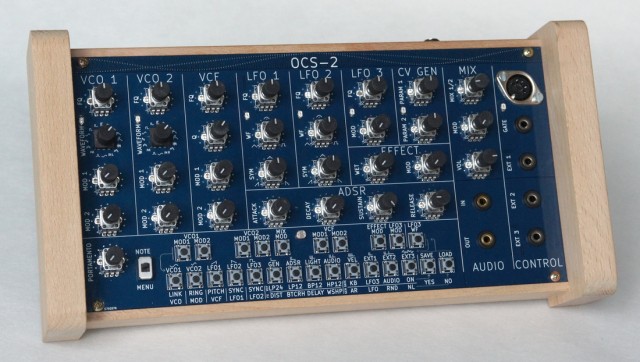
Developer Cyrille Henry let us know about a new Arduino-based monophonic synthesizer, the One Chip Synth (OSC-2).
The OCS-2 is a complete virtual analog synth voice in Eurorack format.
Here are a couple of video demos:
Additional audio demos are also available.
Features:
- 2 VCO providing 15 different waveform
- 1 VCF (multi-mode, including a 24db/Octave low pass resonant filter)
- 1 VCA
- 1 ADSR
- 3 LFO (2 with configurable waveform, 1 with CV frequency control)
- 1 custom CV GENERATOR with 4 different algorithms (Attack Release, dual LFO, Random, Non Linear)
- 1 audio effects processor with 4 different effect (Distortion, delay, bitcrush, waveshaper)
- 1 ring modulator
- 1 CV controlled MIX (for VCO1 and VCO2)
- 2 octaves keyboard with portamento
- 1 digital matrix to connect CV to modulation fader
- 1 Stereo line-IN with envelope follower and gate control
- 1 MIDI input (note / velocity / pitch wheel / modulation wheel / control change)
- 3 analog CV IN and 1 GATE IN
- 1 light sensor
Specifications:
- 30 fader, 12 bits input
- 48KHz audio synthesis
- about 10KHz for CV computation
- 24 bits audio ADC and DAC
- 32 bits audio synthesis
- 82 dB S/N ratio for the audio line-out (measured)
- 0.15 ms IN/OUT audio latency
- cortex M3 32 bits micro-controller (arduino due)
- 7 to 12V power supply (1 standard 2mm power plug or 1 standard eurorack plug)
- low power consumption (300mA @ 12V)
- 3U, 10 inches (50HP) eurorack format
- 254 x 128.5 x 50 mm (290 x 139 x 55mm for the box)
- about 270g (750g with the wood box)
Additional details are available from Henry via his site.

love the different versions they have
one for those who think outside the box
wow all these amazing arduino synths are so exciting. I really want a SLightly larger NS1/ But this is tempting. hoping its cheap or I can just get a pcb etc…
Looks amazing, but HOW MUCH IS IT?!!?!?!
It’s a softsynth on a rack?
Many of the most popular Euro modules are digital – Audio Damage, Synth Tech, Mutable Instruments, etc.
Get over it!
There are always these guys, the thing is that these people just use presets and don’t wiggle, and in turn don’t understand the tactile nature that makes a machine feel like a true instrument. That is why a synth or VST comes with loads of presets.
Presets are an excellent “example” for the capabilities of an instrument, a great “start” for developing your own sound and an always-open for improvement “finish” of a song.
Without presets, you just improvise and improvise, which is great, if that’s what you’re into. But as much as art is just for art’s sake, sometimes art is for the people – the masses, who vastly prefer musical composition coated in recognisable instruments (which is no less of an art), to “never hearing the same improvisation of instrument-parameter tweaking, again”.
So, having 2(+) different types of usages of the same basic tools, doesn’t mean one is right and the other is wrong – they are just different.
Cheers!
Cool story bro ????
2 vco is that it??????? i require more i’m board with 2 osc,loads of vst have 2 .
i want to have 8 or 15
There are actually zero VCOs in this design because it’s digital. Adding more oscillators would require even more controls and wouldn’t dramatically change the sound.
if a digital oscillator is voltage controlled doesn’t that make it a vco?
I almost got excited there with the word “Arduino” in the title, but then when I clicked the link it took me to a webshop for preordering.
Thanks, but no thanks.
Schematics or gtfo.
Just because you use an Arduino in a device doesn’t mean you have to give away its design.
The wonderful thing about Arduinos, Beagleboards, RasPis and other cheap single board computers is that they allow you to make short runs of products that might not be financially viable otherwise.
Sounds really good and clean for a one chip synth, meaning it outputs really what you set it up to do without additionals such as aliasing, noise etc. I’d like some more info about physical dimensions, pricing etc. but it promises to be an interesting basic component of a modular as well as a stand alone.
Looking at the scope (vid 1) you can clearly see and hear that the amplitude is reduced as the pitch go higher, some waveforms excluded. So, is that a bug or a feature?
The reduction of the amplitude as the oscillator sweeps up is probably the filter doing it’s job – rolling off beyond a certain frequency.
Pretty cool. I actually rather enjoyed the oscilloscope renderings of the filtered waves with resonance. It helped me understand exactly what’s going on with resonance.